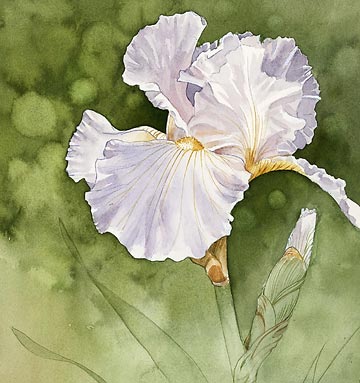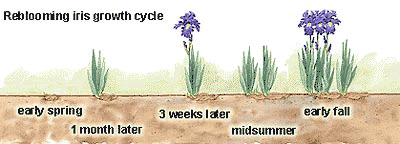





 'Immortality' is one of the most
popular and reliable reblooming
irises.
'Immortality' is one of the most
popular and reliable reblooming
irises.
When summer's lush greenness gives way to the sunset hues of autumn, you'd expect the garden to overflow with asters and chrysanthemums. But bearded iris? How did this flouncy flower of spring transform itself into an autumn beauty? Obviously, these aren't ordinary irises. These are reblooming irises, and they're changing the look of fall gardens.
In spring, it would take a trained eye to spot any differences between reblooming irises and the more common once-blooming varieties. Both types flaunt sweet-scented fleurs-de-lis over a fan of leaves. But while most irises sit out the summer, rebloomers multiply in a frenzy of growth. By late summer or fall they're ready to flower again. Where the growing season is long enough, reblooming irises are known to squeeze in a third or even a fourth flush of flowers.
Related Slide Show: Top Reblooming Iris
continue reading belowAlthough commonly called rebloomers, there are actually several types within this category, according to the Reblooming Iris Society:
There are two "catches" to this classification system: first, most retailers will simply say that a variety they carry reblooms, not what type of rebloomer it is. The other catch is that there are no guarantees that any particular variety in any particular setting will behave in any particular way. That said, most of the irises labeled as rebloomers by reliable suppliers will give you far more "bang" for your flower buck.
In general, the reliability of rebloom declines as you go farther north. Gardeners in Zones 3 and 4 may see little or no reblooming. (The exception is the variety 'Immortality', which is reputed to rebloom as far north as Zone 3.) In most varieties, the reblooming cycle is set off by cooler weather, so if your temperatures are tropical year round, you may not see a second bloom. Also, some varieties will not start reblooming for a couple of years, so patience is a virtue.
Learn more about maintaining and dividing irises.

Because they are doing more work throughout the growing season, reblooming iris need a bit more attention than regular varieties. Use a low-nitrogen fertilizer (one with a small first number, such as 5-10-20), following package directions. To prevent burning, don't allow the fertilizer to remain on the exposed rhizomes.
Feed the plants lightly in spring as growth starts, and again in September. Water every other week to keep the soil moist and prevent the plants from going into dormancy. This much water can cause regular irises to rot, so it's best to keep your rebloomers apart from your regular irises.
Reblooming irises grow faster than regular irises, so you'll need to divide them more often. To prevent overcrowding, divide reblooming iris every two to three years, but take only the outside rhizomes of the plant; leave the healthy older portions of the plant intact. Replant the small rhizomes 12 to 18 inches apart.
Like other irises, rebloomers can fall prey to iris borers and a variety of diseases. If you spot signs of decline, talk to your county extension service about steps you need to take.
Related Garden Plan: Pink and Blue Garden with Irises
The large majority of rebloomers are bearded iris, though some Siberian, Japanese, and other species offer this trait.
Below are some of the most reliable reblooming bearded iris. Note: the time of bloom refers to the first flowering.
Related Slide Show: Top Reblooming Iris
Copyright © www.100flowers.win Botanic Garden All Rights Reserved